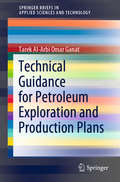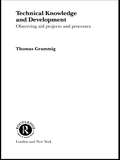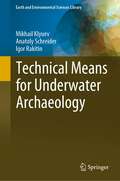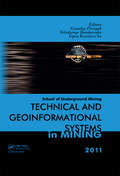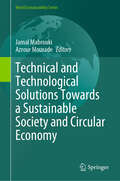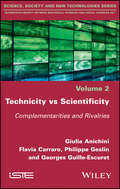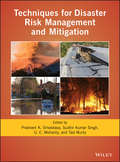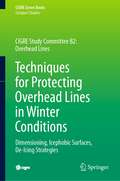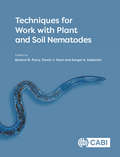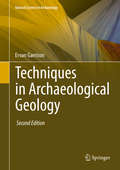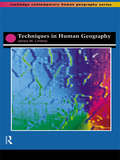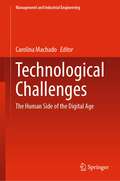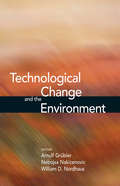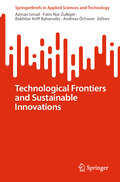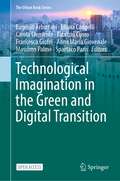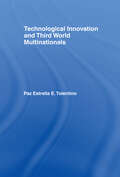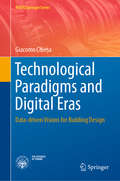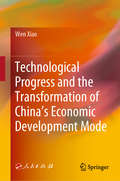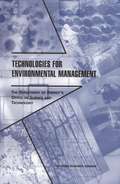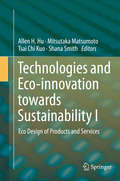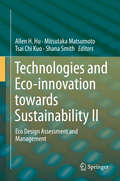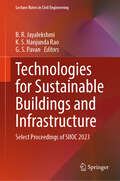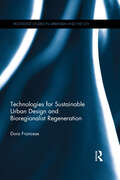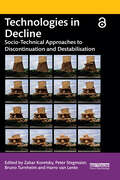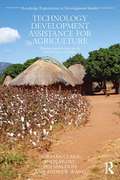- Table View
- List View
Technical Guidance for Petroleum Exploration and Production Plans (SpringerBriefs in Applied Sciences and Technology)
by Tarek Al-Arbi GanatThis book presents detailed explanations of how to formulate field development plans for oil and gas discovery. The data and case studies provided here, obtained from the authors’ field experience in the oil and gas industry around the globe, offer a real-world context for the theories and procedures discussed. The book covers all aspects of field development plan processes, from reserve estimations to economic analyses. It shows readers in both the oil and gas industry and in academia how to prepare field development plans in a straightforward way, and with substantially less uncertainty.
Technical Knowledge and Development: Observing Aid Projects and Processes (Routledge Studies in Development and Society #Vol. 11)
by Thomas GrammigDevelopment and aid projects often fail to improve technological capacity. Their reform has been a widely acknowledged challenge for three decades. This book demonstrates theoretically and empirically how aid practitioners shape the organizational, social and inter-cultural dynamics of development projects in industry.
Technical Means for Underwater Archaeology (Earth and Environmental Sciences Library)
by Mikhail Klyuev Anatoly Schreider Igor RakitinThe book discusses various aspects of the technical support of underwater archaeological research in marine and freshwater areas. This book considers the relevance, specificity, and artifacts of underwater archaeological research, stating the factors of flooding of archaeological artifacts. The authors describe the basic equipment for underwater work, as well as the equipment for remote study of the bottom and underwater archaeological research. This book presents the usage of instrumentation in underwater archaeology. Case studies included in this book correspond to the flooded ancient Greek cities of Fanagoria and Patraeus in the Taman Bay of the Black Sea, flooded Neolithic settlements on Lake Sennitsa in the Pskov region of Russia, sunken ships in the north of the Black Sea and sunken liner “Titanic” in the Atlantic Ocean. The book is intended for students, graduate students and archaeologists who are interested in the specifics of underwater archaeological research and are planning to conduct it.
Technical and Geoinformational Systems in Mining: School of Underground Mining 2011
by Genadiy Pivnyak Volodymyr Bondarenko Iryna Kovalevs’kaNew trends of mineral deposits mining in the world consist of intensifying and concentration of mining operations. This is achieved with the help of new technical equipment that is more reliable, having greater service life and more available power. Consideration is given to quantity reduction of stopes and development workings together with t
Technical and Technological Solutions Towards a Sustainable Society and Circular Economy (World Sustainability Series)
by Jamal Mabrouki Azrour MouradeResource depletion and ecological risks are more than ever at the heart of societal and economic debates. In the 1970s, the developed countries saw the Fordist growth regime crumble in parallel with the growing awareness of the ecological issue. Since the first industrial revolutions, technological dynamics have been the cause of many environmental problems, and there is a consensus on the diagnosis. Integrated technologies reduce resource use and/or pollution at source by using cleaner production methods. This generally leads to a reduction in the by-products, energy inputs and resources used by companies to produce goods.Integrated production technologies reduce negative environmental impacts at source by substituting or modifying cleaner technologies. Examples of integrated, or cleaner, production technologies are the recirculation of materials, the use of environmentally friendly materials (such as the substitution of water for organic solvents), etc. However, the implementation of integrated production technologies is often hampered by obstacles related to cost, coordination and skill inertia problems and to the productive organisation of companies. In addition to the high investment costs of new integrated technologies, additional barriers may emerge depending on the nature of the environmental problem and the type of environmental regulation in question.
Technicity vs Scientificity: Complementarities and Rivalries
by Georges Guille-Escuret Flavia Carraro Giulia Anichini Philippe GeslinThe relationship between technicity and scientificity is often overlooked or avoided despite being a determining factor for establishing interdisciplinarity. By focusing on this relationship and highlighting a number of its ramifications, this book sheds light on the hidden or skewed stakes that condition a wide array of scientific projects. The authors present different approaches based on their own professional experience, focusing on the technique–science relationship in domains as diverse as brain mapping, the decipherment of Mycenaean writing and the design process. Each chapter presents varying and often opposing epistemological conclusions to provide the reader with a wide breadth of examples in different fields. Although the scope of this book is far from exhaustive, it serves as a starting point for the necessary and long-overdue clarification of the relationship between these neighboring, yet disjointed, sectors.
Techniques for Disaster Risk Management and Mitigation
by Prashant K. Srivastava U. C. Mohanty Sudhir Kumar Singh Tad MurtyA comprehensive guide to managing and mitigating natural disasters Recent years have seen a surge in the number, frequency, and severity of natural disasters, with further increases expected as the climate continues to change. However, advanced computational and geospatial technologies have enabled the development of sophisticated early warning systems and techniques to predict, manage, and mitigate disasters.Techniques for Disaster Risk Management and Mitigation explores different approaches to forecasting disasters and provides guidance on mitigation and adaptation strategies. Volume highlights include: Review of current and emerging technologies for disaster prediction Different approaches to risk management and mitigation Strategies for implementing disaster plans and infrastructure improvements Guidance on integrating artificial intelligence with GIS and earth observation data Examination of the regional and global impacts of disasters under climate variability
Techniques for Protecting Overhead Lines in Winter Conditions: Dimensioning, Icephobic Surfaces, De-Icing Strategies (CIGRE Green Books)
by Masoud Farzaneh William A. ChisholmThis book offers a comprehensive review of the various options for improving the performance of overhead power lines in winter conditions, taking into account both mechanical and electrical aspects. Experience within the CIGRE community reveals many strategies to protect overhead power lines from damage caused by heavy build-up of ice and snow or electrical issues such as insulator icing flashovers. The initial approach is to consider the predicted ice loads from the available databases. This is supplemented with some fundamental aspects of icing physics that affect accretion rate as well as factors in ice shedding on traditional (metal, ceramic) and novel treated surfaces. These ice physics concepts structure the ways to categorize and evaluate methods to reduce or prevent icing on conductors and ground wires or to prevent flashover of insulators. Many utilities in cold climate regions have developed and used methods and strategies to reduce ice loads using anti-icing (AI) and / or de-icing (DI) methods. In general, AI methods are used before or early during ice build-up, while DI methods are activated during and sometimes after ice build-up. The book describes and discusses some historical, operational, or potential AI / DI systems in the ice physics context. This supports a comprehensive review of AI coatings including concepts, relevant material properties, application methods, and finally test methods for characterizing the long-term performance.
Techniques for Work with Plant and Soil Nematodes
by Roland N. Perry Sergei A. Subbotin David J. HuntPlant-parasitic and free-living nematodes are increasingly important in relation to food security, quarantine measures, ecology (including pollution studies), and research on host-parasite interactions. Being mostly microscopic, nematodes are challenging organisms for research. Techniques for Work with Plant and Soil Nematodes introduces the basic techniques for laboratory and field work with plant-parasitic and free-living soil-dwelling nematodes. Written by an international team of experts, this book is extensively illustrated, and addresses both fundamental traditional techniques and new methodologies. The book covers areas that have become more widespread over recent years, such as techniques used in diagnostic laboratories, including computerized methods to count and identify nematodes. Information on physiological assays, electron microscopy techniques and basic information on current molecular methodologies and their various applications is also included. This book is an essential resource for students of nematology and parasitology, academic researchers, diagnostic laboratories, and quarantine and advisory service personnel. It provides a much-needed methodology standard for anyone involved in work on plant and soil nematodes.
Techniques in Archaeological Geology
by Ervan GarrisonThis 2nd edition is a survey level review of key areas of archaeological geology/geoarchaeology. Principal subject areas include: historical principles; archaeologic and geomorphic surfaces and landforms types; sediments and sediment analytic methods; archaeological stoney materials - petrographic and mineralogic attributes; ceramic materials - mineralogic composition and analytic methods; geochemical methods useful in archaeological geology - studies of materials; commonly used geochronological methods for archaeological geology. Contributions to paleoecology, paleoclimate and ancient cultures as well as multivariate ICP and EDX data are now included.
Techniques in Human Geography
by Jim LindsayThe first concise guide to the purposeful use of techniques in human geography. Examining key techniques in detail - survey and qualitative, numerical, spatial and computer-based - the book draws on important case studies, such as the decennial census, to illustrate applications. The importance of up-to-date IT based techniques is particularly stressed, introducing widely recognised applications. A final section explores the Internet, which offers exciting new resources but also creates problems for researchers used to traditional academic fields.
Technological Challenges: The Human Side of the Digital Age (Management and Industrial Engineering)
by Carolina MachadoThis book discusses and exchanges information on principles, strategies, models, techniques, methodologies and applications of technological challenges in a digital era. It helps the reader to develop the skills required in the digital age and to acquire the knowledge and know-how necessary to drive their organizations to success. This book presents contributions that are exceptional in terms of theory and/or practice in the area of human resources management, technological management, digital age, creativity, technological innovation, organizational innovation, business analytics and flexibility.
Technological Change and the Environment
by Nebojsa Nakicenovic William D. Nordhaus Arnulf GrüblerMuch is written in the popular literature about the current pace of technological change. But do we have enough scientific knowledge about the sources and management of innovation to properly inform policymaking in technology dependent domains such as energy and the environment? While it is agreed that technological change does not 'fall from heaven like autumn leaves,' the theory, data, and models are deficient. The specific mechanisms that govern the rate and direction of inventive activity, the drivers and scope for incremental improvements that occur during technology diffusion, and the spillover effects that cross-fertilize technological innovations remain poorly understood. In a work that will interest serious readers of history, policy, and economics, the editors and their distinguished contributors offer a unique, single volume overview of the theoretical and empirical work on technological change. Beginning with a survey of existing research, they provide analysis and case studies in contexts such as medicine, agriculture, and power generation, paying particular attention to what technological change means for efficiency, productivity, and reduced environmental impacts. The book includes a historical analysis of technological change, an examination of the overall direction of technological change, and general theories about the sources of change. The contributors empirically test hypotheses of induced innovation and theories of institutional innovation. They propose ways to model induced technological change and evaluate its impact, and they consider issues such as uncertainty in technology returns, technology crossover effects, and clustering. A copublication o Resources for the Future (RFF) and the International Institute for Applied Systems Analysis (IIASA).
Technological Frontiers and Sustainable Innovations (SpringerBriefs in Applied Sciences and Technology)
by Andreas Öchsner Azman Ismail Fatin Nur Zulkipli Bakhtiar Ariff BaharudinThis book takes a deep dive into the industrial sphere, exploring subjects such as aerospace development, knowledge management in higher education, and the emergence of a nation as a player in the global space race. This insightful compilation of chapters offers an essential guide to navigating the complexities of modern industry, offering valuable insights and solutions to propel businesses and society toward a sustainable future.
Technological Imagination in the Green and Digital Transition (The Urban Book Series)
by Massimo Palme Eugenio Arbizzani Eliana Cangelli Carola Clemente Fabrizio Cumo Francesca Giofrè Anna Maria Giovenale Spartaco ParisThis open access book addresses the pressing need for sustainability in urban development and the use of technology, with cities to serve as the main stage for strategies that seek to meet the targets and the cross-sector priorities indicated in the EU’s Next Generation program, all in pursuit of a solid recovery on the part of the European economy, along lines of ecological transition, digitalization, competitiveness, training, and inclusion to overcome social, territorial, and gender differences.The international study encounter is meant to promote visions shared by architectural technology and other disciplines, which, though they may appear to differ, are closely interconnected, with the aim of achieving an open, interdisciplinary integration capable of proposing concrete projects regarding topics held to be of strategic importance to the future of the built environment. These are identified to draw up evolving scenarios of architecture and cities suited to reflection, at various levels, on innovative models of process and product.
Technological Innovation and Third World Multinationals
by Paz Estrella TolentinoThis examines the relationship between technological growth and outward direct investment from firms in Asia and Latin America which has become increasingly siginificant as these countries develop.
Technological Paradigms and Digital Eras: Data-driven Visions for Building Design (PoliTO Springer Series)
by Giacomo ChiesaThe book connects the ICT and the architectural worlds, analyzing modeling, materialization and data-driven visions for design issues at different scales. Furthermore, using sample modeling and materialization tools, it explores the links between performance-driven design approaches and the application of new digital technologies. Intended for architects and urbanists, it provides a theoretical framework to address the implications of the digital revolution in building design and operation. Furthermore, combining insights from IT and ICT with architectural and urban design know-how, it offers engineering professionals a technology-driven interpretation of the building design field.
Technological Progress and the Transformation of China’s Economic Development Mode
by Wen XiaoThis book explores how technological progress accelerates the transformation of economic development by adopting a fundamental logical approach to technological progress, intensive inputs, and promotion of productive efficiency to transformation of economic development. It investigates the internal mechanisms and the choice of corresponding modes that initiate technological progress to accelerate the transformation of economic development at three basic research levels: micro-enterprise level, mid-industry level and macro-economy level. Based on the above research, the book summarizes four dimensions facilitating the transformation: agricultural intensification, new industrialization, modernization of the service industry and the advanced manufacturing industry, and linkage of the modern service industry. This book is especially valuable in its hierarchical categorization covering theoretical, empirical, industrial and strategic exploration. On one hand, it analyzes the mechanisms and approaches influencing the transformation of economic development driven by technological progress from both theoretical and empirical perspectives. On the other hand, based on the introduction of advanced international experiences, it probes into the guarantee basis for the strategic implementation and the corresponding mode choices of the transformations. Furthermore, it offers specific policy proposals from both the macro level of how technological progress promotes the transformation of economic development and the micro level covering the agricultural, industrial and service industries.
Technologies For Environmental Management: The Department Of Energy's Office Of Science And Technology
by Board on Radioactive Waste ManagementThe National Academies Press (NAP)--publisher for the National Academies--publishes more than 200 books a year offering the most authoritative views, definitive information, and groundbreaking recommendations on a wide range of topics in science, engineering, and health. Our books are unique in that they are authored by the nation's leading experts in every scientific field.
Technologies and Eco-innovation towards Sustainability I: Eco Design of Products and Services
by Mitsutaka Matsumoto Allen H. Hu Tsai Chi Kuo Shana SmithThis 2-volume book covers the state-of-the-art of the research and practices on eco-design. It covers the latest topics in the field: e.g. global eco-design management, big data in eco-design, social perspectives in eco-design; as well as emphasizing the developments in emerging economies such as Asian countries. Eco-design of products and product-related services are indispensable to realize the circular economy and to increase resource efficiencies of our society. Eco-design practices are necessary both in developed countries and developing countries. The book chapters are contributed by the worldwide authors, especially authors from East Asian countries, European countries, and Southeast Asian countries, and contains selected presentations at the EcoDesign2017 symposium (10th International Symposium on Environmentally Conscious Design and Inverse Manufacturing). The first volume highlights products and services, the chapters include the product life cycle design and business strategy, technologies for the future and sustainability, as well as social perspectives in eco-design.
Technologies and Eco-innovation towards Sustainability II: Eco Design Assessment and Management
by Mitsutaka Matsumoto Allen H. Hu Tsai Chi Kuo Shana SmithThis 2-volume book covers the state-of-the-art of the research and practices on eco-design. It covers the latest topics in the field: e.g. global eco-design management, big data in eco-design, social perspectives in eco-design; as well as emphasizing the developments in emerging economies such as Asian countries. Eco-design of products and product-related services are indispensable to realize the circular economy and to increase resource efficiencies of our society. Eco-design practices are necessary both in developed countries and developing countries. The book chapters are contributed by the worldwide authors, especially authors from East Asian countries, European countries, and Southeast Asian countries, and contains selected presentations at the EcoDesign2017 symposium (10th International Symposium on Environmentally Conscious Design and Inverse Manufacturing).The second volume focus on assessment and management, including topics such as sustainable manufacturing and End of Life (EOL) management, sustainability assessment, policy and regulations and Incentives for eco-design.
Technologies for Sustainable Buildings and Infrastructure: Select Proceedings of SIIOC 2023 (Lecture Notes in Civil Engineering #528)
by B. R. Jayalekshmi K. S. Nanjunda Rao G. S. PavanThis book presents select proceedings of the International Conference on Sustainable Infrastructure: Innovations, Challenges and Opportunities 2023 (SIIOC 2023). The topics covered include behavior of masonry and RC buildings under earthquakes, performance of concrete, bricks and blocks manufactured with non-organic industrial wastes, bamboo for construction, composites for construction, and finite element simulations on buildings and special structures. The book presents various facets of experiments to characterize the properties of construction materials and intricacies involved in performing finite element simulations to assess the behavior of buildings under seismic and wind loading conditions. The book serves as a resource material for budding researchers and industry professionals interested in developing solutions for sustainable building habitats.
Technologies for Sustainable Urban Design and Bioregionalist Regeneration (Routledge Studies in Urbanism and the City)
by Dora FranceseThis book explores the role of technology in ecological urban design and regeneration. Part I provides theoretical and methodological insights into technological approaches that offer optimum respect to existing cultural and natural environments, while offering minimum impact and carbon footprint. Parts II and III provide contextualised examples that demonstrate the use, or proposal of, sustainable technologies and solutions for regenerating parts of the urban and peri-urban. The case studies offer insights from the Mediterranean and the Middle East in a diverse range of spaces, from central urban squares, oblique cities, urban waterfronts, decaying suburbs, to peri-urban areas such as touristic waterfronts, former industrial areas, hyper-commercial areas, humid zones and parks.
Technologies in Decline: Socio-Technical Approaches to Discontinuation and Destabilisation
by Harro Van Lente Bruno Turnheim Peter Stegmaier Zahar KoretskyThe central questions of this book are how technologies decline, how societies deal with technologies in decline, and how governance may be explicitly oriented towards parting with ‘undesirable’ technology. Surprisingly, these questions are fairly novel. Thus far, the dominant interest in historical, economic, sociological and political studies of technology has been to understand how novelty emerges, how innovation can open up new opportunities and how such processes may be supported. This innovation bias reflects how in the last centuries modern societies have embraced technology as a vehicle of progress. It is timely, however, to broaden the social study of technology and society: next to considering the rise of technologies, their fall should be addressed, too. Dealing with technologies in decline is an important challenge or our times, as socio-technical systems are increasingly part of the problems of climate change, biodiversity loss, social inequalities and geo-political tensions. This volume presents empirical studies of technologies in decline, as well as conceptual clarifications and theoretical deepening. Technologies in Decline presents an emerging research agenda for the study of technological decline, emphasising the need for a plurality of perspectives. Given that destabilisation and discontinuation are seen as a way to accelerate sustainability transitions, this book will be of interest to academics, students and policy makers researching and working in the areas of sustainability science and policy, economic geography, innovation studies, and science and technology studies.
Technology Development Assistance for Agriculture: Putting research into use in low income countries (Routledge Explorations in Development Studies)
by Andrew Ward Norman Clark Andy Frost Ian MaudlinStemming from an 11-year DFID funded programme under its Renewable Natural Resources Research Strategy (RNRRS), Technology Development Assistance for Agriculture: Putting Research into Low Income Countries reviews part of this programme as a case study of a broader issue of technology development for Africa. Controversially, it critiques current international technology development assistance and focuses on the potential role of the private sector in agricultural technology development as well as providing insights for future cognate science policy and practice. The book focuses on the RIU "Best Bets" Africa sub-programme. This identified promising proposals to take existing agriculture research products and put these into use in ways that would benefit the poor in developing countries. The sum set aside for this was £5 million. The empirical sections of the book cover project selection, progress and programme management over a 2009-2012 period with special attention paid to lessons learned that may have implications for future cognate technology development assistance. This topical book gives direct evidence of meeting objectives and delivering real changes in technology development for Africa to postgraduate students, researchers, international bodies, NGOs, policy makers and government organisations working on natural resource management, technology development assistance, and low income country agriculture.
